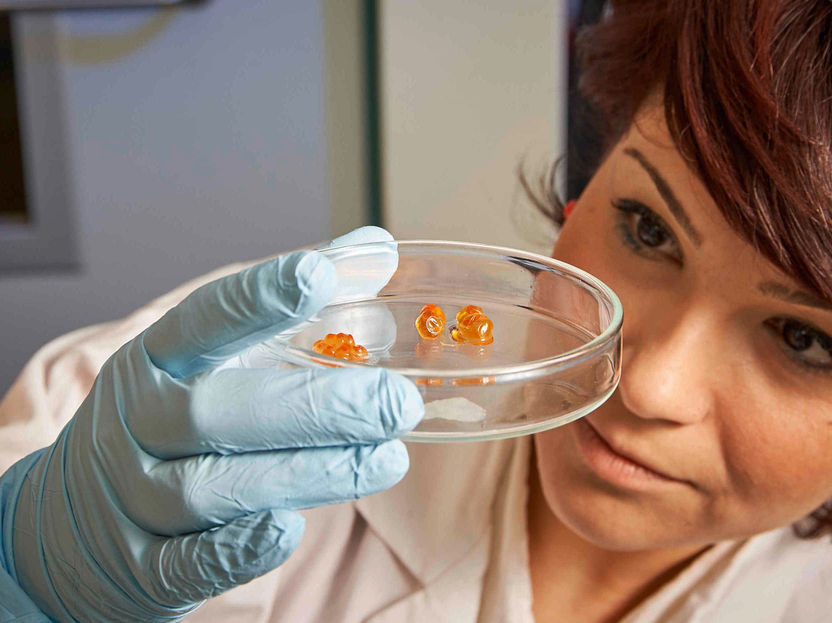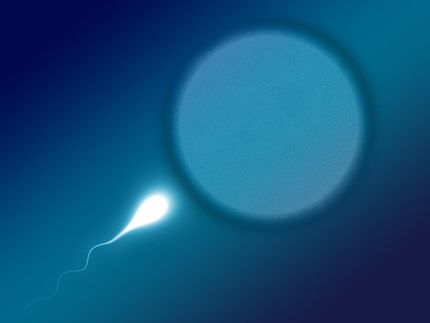The sweet side of reproductive biology
Sugars that can modulate the immune system
Advertisement
At present, sugar is under general suspicion of being responsible for many widespread diseases and health problems of mankind, especially in the industrial nations. These are mostly sugars made from glucose or fructose, like our household sugar sucrose. However, sugar is more than just a pure source of energy.

Doctoral student Marzia Tindara Venuto with fish eggs in a Petri dish.
FBN
The body itself produces a whole battery of complex carbohydrates, which are composed of a wide variety of monosaccharides. Perhaps the most prominent of these is the sugar polymer heparin, whose use in the inhibition of blood coagulation in medicine has become indispensable. At the Leibniz Institute for Farm Animal Biology in Dummerstorf, the junior research group "Glycobiology" headed by Sebastian P. Galuska has been researching the role of sugar molecules in reproduction with great success since 2016. Glycobiology is the science of the structure, biosynthesis and biology of the body's own sugar chains (saccharides or glycans).
"Together with national and international cooperation partners, we are investigating the role of complex sugar molecules in reproductive immunology, as numerous studies show that these glycans are used as a kind of ID card by living organisms to identify themselves in front of cells of the immune system. All our cells are coated with a sugar layer consisting of a large number of different glycoconjugates," explains group leader Sebastian P. Galuska.
After sexual intercourse, the immune system in the female reproductive tract is activated, which should actually lead to the killing of foreign invaders, i.e. the sperm, and thus to infertility. However, there are numerous molecules in the ejaculate and on the surface of the sperm that can influence the immune system. For example, if certain sugar molecules are missing on the surface of sperm, their "ID card" is faulty. As a result, they can no longer correctly identify themselves to female immune cells and are therefore repelled. They are eaten (phagocytised) by the defence cells or trapped and killed by so-called "neutrophil extracellular traps". "Our focus is to identify naturally occurring sugar structures, e.g. on sperm or in seminal fluid, which can specifically influence mechanisms of the immune system. The search for such sugar molecules has now been extended to milk and fish. The Justus Liebig University of Gießen, the Hanover Medical School, the State Research Institute for Agriculture and Fisheries M-V in Born, the University of Natural Resources and Applied Life Sciences Vienna (Austria), the University College Dublin (Ireland) and the universities in Pécs (Hungary) and Lille (France) are involved in the search.
DNA nets as traps for sperms
The so-called "neutrophil extracellular traps" are also in focus. This is a kind of network consisting of DNA and numerous antimicrobial components. Similar to insects entering the spider web, bacteria and other pathogens are trapped and killed in the body. In principle, this would also happen if "exogenous" sperm met female neutrophils. However, the sperm and seminal fluid are equipped with numerous biomolecules in order to escape these natural immune reactions and thus reach their destination unharmed.
Bypassing the female defensive traps
"Together, we are analysing which structural prerequisites sugar molecules on sperm have to fulfil in order to circumnavigate the many obstacles to the ovum and whether such sugar-dependent mechanisms also take place elsewhere in the body or could play a role in diseases," explained the biotechnologist. The most diverse sugar molecules could thus be used as the body's own therapeutics to develop biomedical applications. It would be conceivable to use such natural sugar chains in artificial insemination so that more sperm cells can overcome the 'defence wave' of the female immune system and the fertilisation probability can be increased. Since the increased formation of "neutrophil extracellular traps" also has a negative influence on numerous diseases, such as blood poisoning (sepsis), the use of sugar polymers is also a promising innovative possibility here. "For example, we were able to show that a linear sugar polymer consisting of the sugar component N-acetylneuraminic acid binds histones in "neutrophil extracellular traps" and can be used as a molecular anchor to e.g. attach therapeutic nanoparticles to such structures of inflammatory foci. Sebastian P. Galuska's junior research group was able to identify this polymer, which is known as polysialic acid, as a soluble form in ejaculate but also bound to sperm.
Overall, the results of basic research at the Leibniz Institute for Farm Animal Biology in this area are also of great interest for human medicine, especially in immunology as well as transfusion and reproductive medicine. For top research at FBN, the young scientists have modern equipment at their disposal, including the latest generation of mass spectrometers and laser scanning microscopes for live observation of the formation of such "neutrophile extracellular traps".



























































